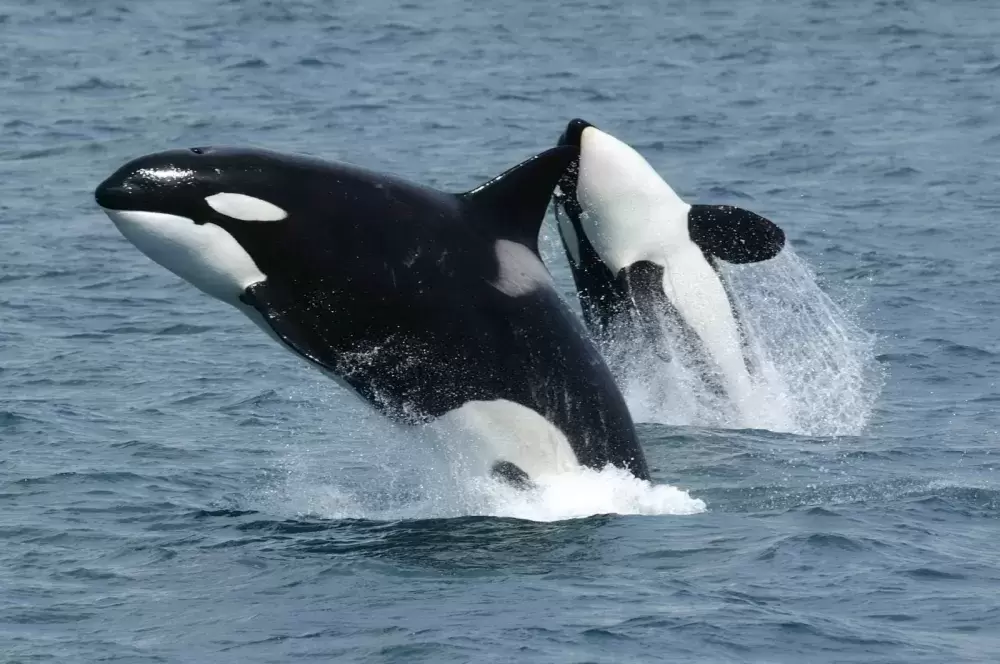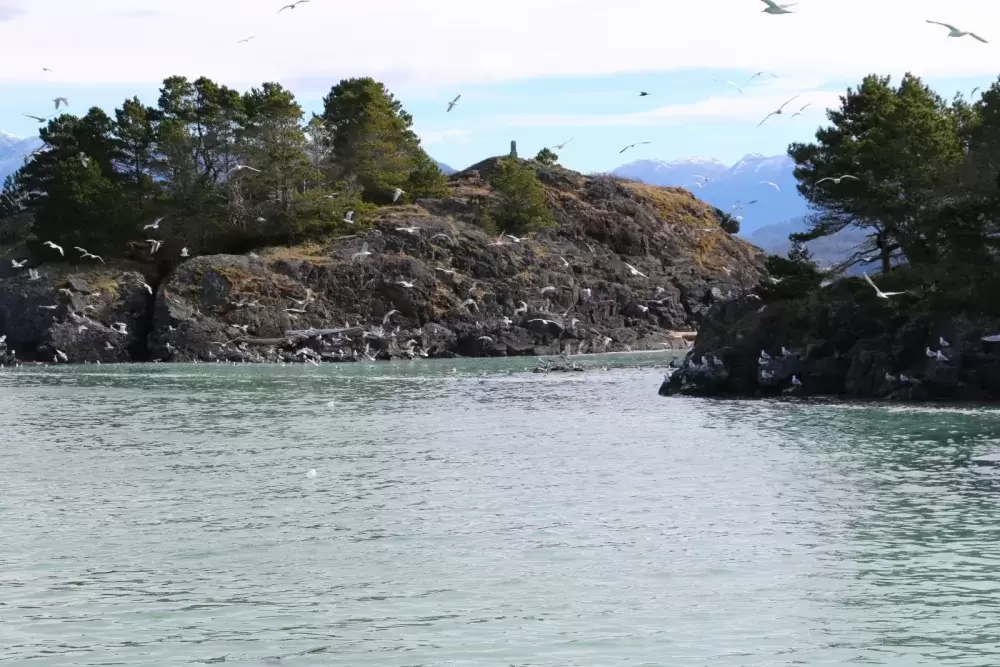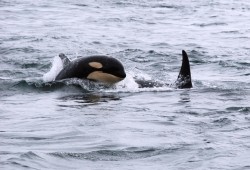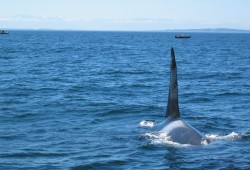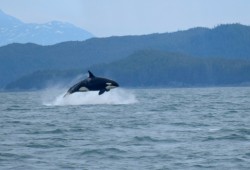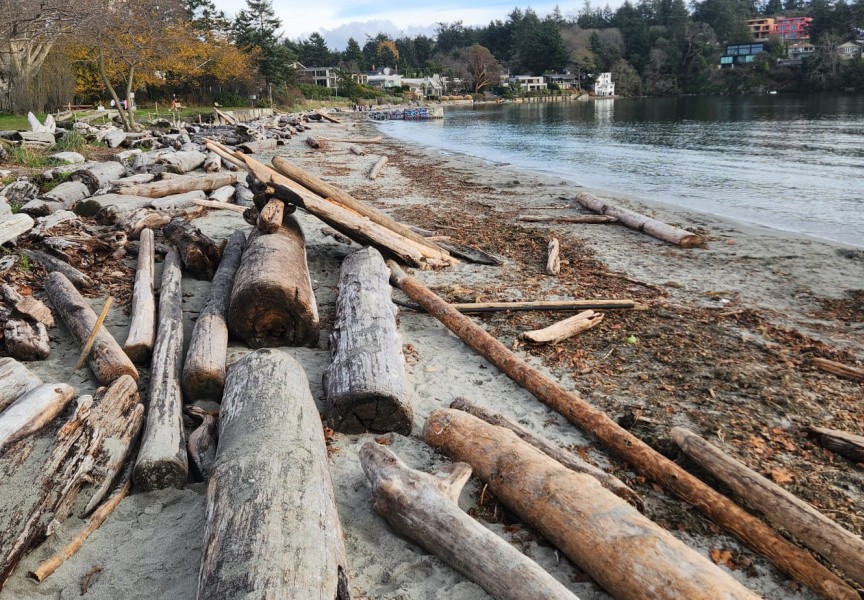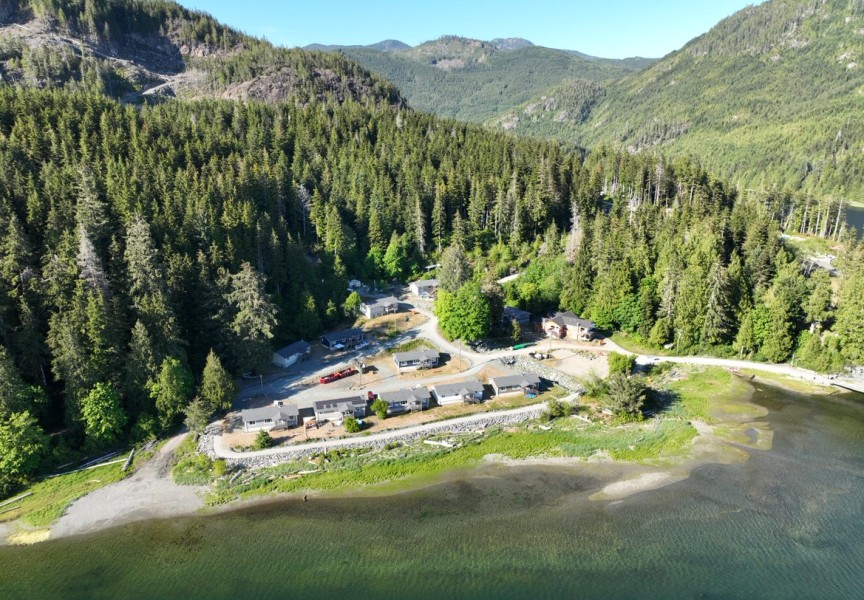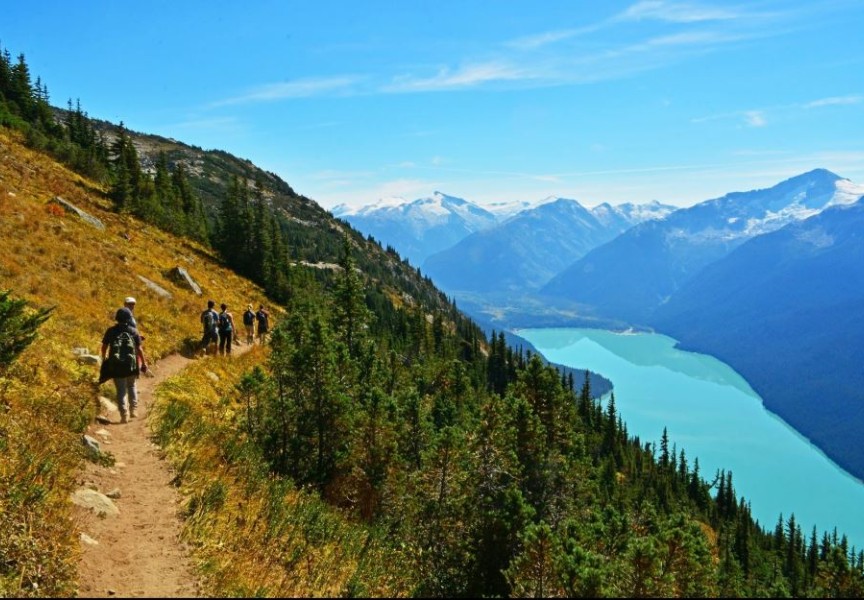The waters around Yuquot were teeming with life on Tuesday, Jan. 18, as residents Ray and Darrell Williams spotted about 100 eagles eyeing salmon, sea lions, humpback whales and a group of orcas with a newborn riding on one of their backs.
“On the back beach we were with them for quite a while,” said Ray of the boat trip he took with his son, when they spotted a group of half a dozen killer whales. “When we got back out again, they were in front of the cove.”
Some of the orcas were small, with a tiny one having a yellowish colour as it rode on the back of another killer whale. Based on Ray’s description it sounds like this is a newborn, said Gary Sutton, a whale research technician at Ocean Wise in Vancouver.
“It’s got a yellowish or pinkish hue when they’re really, really young, in the first six months or so,” he said.
Three types of killer whales traverse the West Coast’s waters: Northern Residents, the endangered Southern Residents and Bigg’s, or transient orcas. Northern and Southern residents feed on salmon, particularly chinook, while the Bigg’s hunts marine mammals, such as seals, sea lions and porpoises. The three ecotypes are not known to interbreed.
Steady population growth
Ray and Darrell most likely spotted Bigg’s orcas, due to the size of the group that passed by their Nootka Island home. Northern and Southern residents usually travel in larger pods than the transient killer whales.
“Most of the time these days when you’re seeing newborn killer whales, they’re usually Bigg’s,” noted Sutton. “It’s because that population, over the last decade, it’s been growing at an annual rate of just over four per cent.”
This growth has occurred despite the ongoing threats of ocean contaminants that pass up the food chain to killer whales, as well as disruptions from vessel traffic.
The population of Bigg’s orcas has grown to approximately 380 that travel throughout the B.C. coast, plus an unknown number of transients that can be found offshore, said Sutton.
“They have become very common,” observed Thomas Doniol-Valcroze, head of the cetacean research program with Fisheries and Oceans Canada. “We know that there’s hundreds and they have been increasing at the maximum possible rate for that species.”
Meanwhile the number of Southern Resident killer whales has dropped to a near 30-year low of 73 or 74, compared to when 95 migrated between southeastern Alaska and Washington State in 1995. The current state of this type of orca has grabbed headlines in recent years and pushed government policy, resulting in fisheries closures in the Juan de Fuca Strait and Swiftsure Bank south of Barkley Sound.
As executive director of the Georgia Strait Alliance, Christianne Wilhelmson closely watches the plight of this endangered orca.
“The threats that Southern Residents encounter transients don’t,” she said. “The majority of sightings in the Salish Sea are not Southern Residents.”
The benefits of eating seals
The disparity between the population health of the two types of killer whales is believed to be due to food availability.
“Killer whales have no natural predators. In that sense they’re like tigers or lions,” said Doniol-Valcroze. “The only thing that controls the population is access to food.”
Southern Residents rely on salmon, particularly chinook, a fish that has seen some stocks approach extinction in recent years. But Bigg’s killer whales mainly hunt seals and sea lions, animals that have grown to stable population levels.
Sutton said this growth began in the 1970s when a government-mandated seal cull stopped.
“They were thought to be part of the reason why the salmon were decreasing,” he explained. “In the ‘60s there were bounties on seals’ heads. You could kill one and get rewarded for it.”
But the pinnipeds rebounded, and by 1995 the West Coast harbour seal population grew to about 105,000, a level that has remained stable since.
“The Bigg’s killer whale population has been recovering along with these seals and keeping them in check in this ecological equilibrium,” added Sutton.
Interference from vessels is also considered a factor in the ability of orcas to get their food. Killer whales use a natural form of sonar, making them particularly vulnerable to sudden disturbances in the environment caused by large boats, stressed Wilhelmson.
“There is some research that shows even a kilometre away, noise from boats can change behaviour in orcas,” she said. “They could be in the middle of a foraging episode, and if a boat comes too close the foraging stops. That’s hugely problematic for a species that’s struggling to get enough food as it is. When boats and ships are changing their habitat and impeding their ability to communicate with each other and feed, that is a big threat.”
But the various ecotypes are affected by vessel traffic differently, which might help to explain the differences in population health. While Southern and Northern Residents eco-locate and make noise all of the time to find fish, Bigg’s killer whales also rely on communication with others in the group.
“That means that Bigg’s killer whales are a lot more silent,” said Doniol-Valcroze, adding that the transients are likely less sensitive to disruptions from vessel noise. “They need to coordinate, they need to speak to one another because they usually hunt as group like a pack of wolves.”
“For a Bigg’s killer whale…they miss out on a seal because they couldn’t hear it over this container ship, they’re going to find another one about 100 metres down the road,” noted Sutton. “Whereas a resident killer whale could find a big juicy chinook and miss out on it because of an acoustic disturbance - that could be the difference between life and death for that animal.”
Toxins that make their way up the food chain
In recent weeks coastal residents have found an increase in man-made debris wash up on their shores – leaving some to wonder if any of this trash came from the 105 shipping containers that went missing from the MV Kingston near Victoria in late October. The presence of synthetic material on the ocean is an ongoing concern, as products like Styrofoam and plastic bottles continue to break down to a microscopic size, allowing it to be ingested by small organisms and make its way up the food chain.
“It becomes part of the zooplankton and then part of the salmon and then part of the whales,” said Wilhelmson. “Then you have the breakdown of those chemicals in their bodies, which impacts their ability to fight disease, their endocrine systems…the females pass it on to their babies.”
The toxins are transferred from mother orcas to their young, an environmental hazard that some believe contributes to the fact that only about half of newborn orcas will survive.
Bigg’s calves have a slightly higher survival rate than their Southern Resident counterparts, a phenomenon that Sutton believes is due to how the toxins can be stored in the animal’s fat.
“If you’re a nice, fat, healthy whale like a Bigg’s killer whale, these toxins are stuck in your fat, it gives you an advantage because you’re not breaking those down,” he explained, noting that the result is different for the leaner Southern Residents. “They’re breaking down their fats using their fat stores, and these chemicals get introduced into their bloodstreams and affect reproductive system, immune system.”
A fluid species with a flexible diet
While it appears to be most likely that the orcas Ray and Darrell Williams spotted are from the growing Bigg’s population, Doniol-Valcroze believes they could also be Northern Residents, another type of killer whale that has seen healthy population growth in recent years. Since the early 1970s Fisheries and Oceans Canada has performed a census of the animals, showing a steady growth among all three Northern Resident clans to 325 in 2020 – an increase of almost four per cent from the previous year.
Unlike the Southern Residents, the Northern orcas have been known to break off to travel in smaller groups.
“It can be anywhere from two to three, to eight, nine, 10 - and sometimes these groups will meet with other groups and create bigger encounters,” said Doniol-Valcroze. “It’s quite fluid.”
Although they also seek out chinook salmon, the Northern Residents appear to be less particular in their diet than the Southern orcas, eating other kinds of salmon and even black cod.
“Their range is larger and occupies most of northern B.C.,” said Doniol-Valcroze. “It could be that they have access to a wider number of salmon runs and salmon populations that gives them a little bit more flexibility. And it could be that they have a slightly more flexible diet too.”
The continued growth of the three North Resident clans has made the west coast of Vancouver Island a necessary region for Canada’s federal fisheries department to survey, as sightings of the ecotype become more frequent.
Whatever type the orcas belonged to, the recent sighting provided an opportunity Ray Williams hasn’t encountered in many years over his life on the Nootka Island coast.
“We haven’t seen that many orcas in a long time,” Ray recounted. “When we did see 30, 40 orcas, it was 40 years ago, but they were all big ones. I’ve never seen a whole bunch of young ones in a bunch.”

